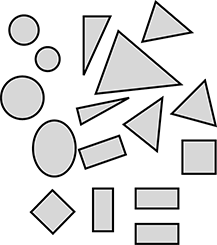Study Guide
Fields 014–017: Early Childhood Generalist
Sample Multiple-Choice Questions
Subtest 2: Mathematics
Objective 0005
Mathematical Computation and Conceptual Skills (Standards 4.1–4.8)
1. Use the information below to answer the question that follows.
A third-grade teacher asks students to solve the addition problem 2996 + 1224 = ______. When the students have finished solving the problem, the teacher asks students to share their strategies and solutions with the class. One student's solution is transcribed below.

The strategy and solution demonstrated in the student work sample indicates that the student has developed facility with:
- additive identity.
- expanded notation.
- proportional thinking.
- number sense.
- Answer
- Correct Response: D.
This question requires the examinee to demonstrate an understanding of the concept of number sense and demonstrate the ability to provide instruction in number sense. Number sense involves an understanding of counting, decomposition, and place value. The equation 2996 + 1224 was chosen by the teacher because it encourages students to look at the value of the numbers and use various strategies. This student uses understanding of place value by noting that 2996 is close to 3000. A strategy of "making a 10 (6+4)" and adding 2996 + 4 = 3000 is employed by decomposing 1224 = 1220 + 4. The student now has an easier equation to solve: 3000 + 1220 = 4220.
Objective 0005
Mathematical Computation and Conceptual Skills (Standards 4.1–4.8)
2. A second-grade teacher plans to create a meeting area by covering  of the classroom floor with a rug. What area should the rug be to cover the meeting area of a classroom that measures 30 feet by 32 feet?
of the classroom floor with a rug. What area should the rug be to cover the meeting area of a classroom that measures 30 feet by 32 feet?
- 62 square feet
- 124 square feet
- 240 square feet
- 960 square feet
- Answer
- Correct Response: C.
This question requires the examinee to demonstrate an understanding of the fundamental concepts of ratios and area in solving mathematical and real-world problems. The meeting area rug must be of the area of the classroom. To find the area of the classroom, apply the formula A = L × W. (30 × 32 = 960 square feet). To find
of the area of the classroom. To find the area of the classroom, apply the formula A = L × W. (30 × 32 = 960 square feet). To find  of the area of the classroom, divide 960 by 4 to obtain 240 square feet.
of the area of the classroom, divide 960 by 4 to obtain 240 square feet.
Objective 0005
Mathematical Computation and Conceptual Skills (Standards 4.1–4.8)
3. Use the diagram below to answer the question that follows.

Four-year-old preschoolers are looking at the collection of shapes shown. Which of the following activities with these shapes would be developmentally appropriate for the teacher to introduce first?
- identifying and naming the shapes
- identifying the shapes that have symmetry
- ordering the shapes from smallest to largest
- describing the shapes by more than one attribute
- Answer
- Correct Response: A.
This question requires the examinee to demonstrate an understanding of methods for planning and delivering developmentally appropriate mathematics instruction. The first level of the understanding of geometric shapes is identifying and naming shapes based on their appearance. Pre-school children should have frequent opportunities to sort and name shapes including squares, circles, triangles, rectangles, and hexagons. It is important to include a variety of each type of shape and in various orientations. By working with different examples of shapes, the student is able to generalize the common features and identify and name shapes based on their appearance. In the second stage of development, students are able to analyze shapes based on their properties and attributes.
Objective 0006
Mathematics Literacy and Instruction (Standards 4.9–4.11)
4. A second-grade teacher is selecting a task for her students to complete before morning meeting. Which of the following problem-solving activities would be most developmentally appropriate for second-grade students?
- There are four blocks on the table and five blocks in the closed box on the table. Find the number of blocks in all, without opening the box.
- Using addition or subtraction, find the next number in the pattern 23, 21, 19, 17, ... . How did you find your answer?
- Look at the chart of favorite colors of students in the class. How many students have chosen red as their favorite color?
- The number 24 can be written in different ways using multiplication. One example is 2 × 12 = 24. Find as many ways as you can to write 24 by multiplying two numbers.
- Answer
- Correct Response: B.
This question requires the examinee to demonstrate an understanding of methods for planning and delivering developmentally appropriate mathematics instruction. In grade two, students use addition and subtraction within 100 to solve problems. One way to help students gain fluency is by having them identify patterns in a sequence of two-digit numbers involving addition and subtraction. This activity is especially beneficial since it also requires students to explain their thinking.
